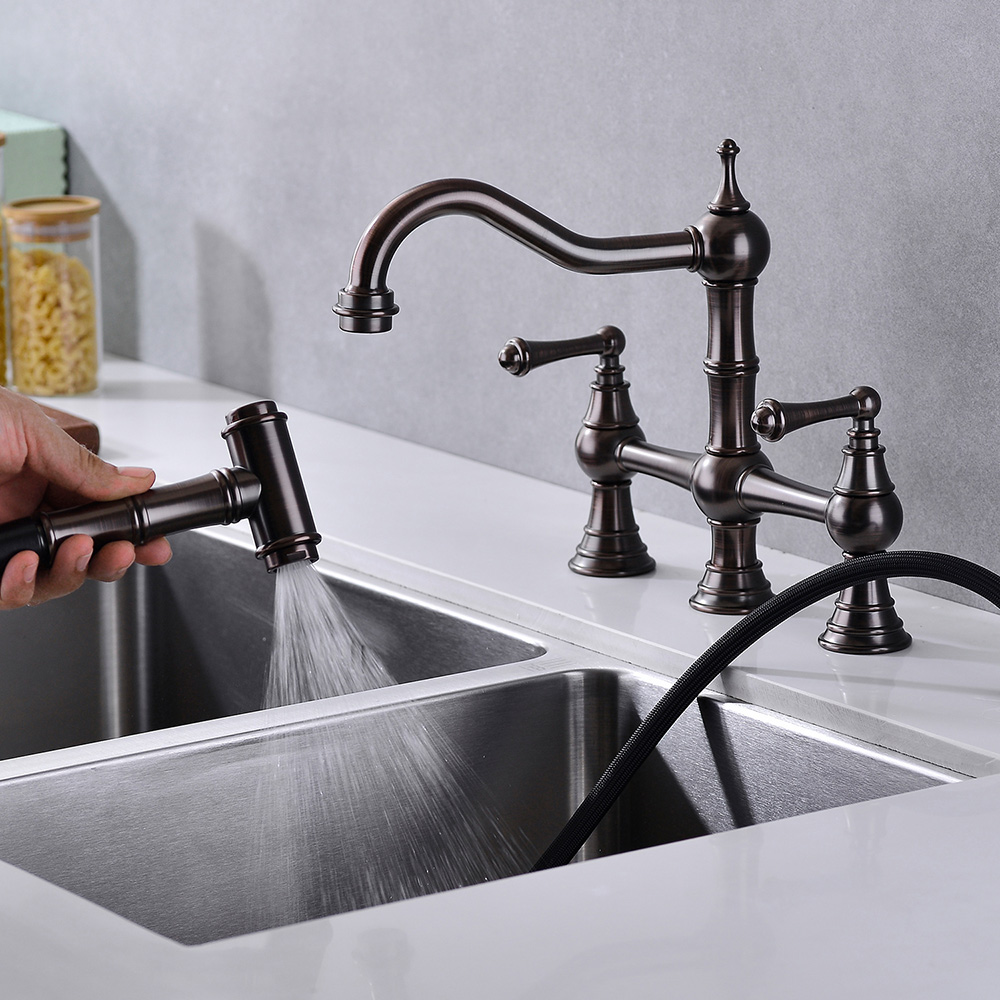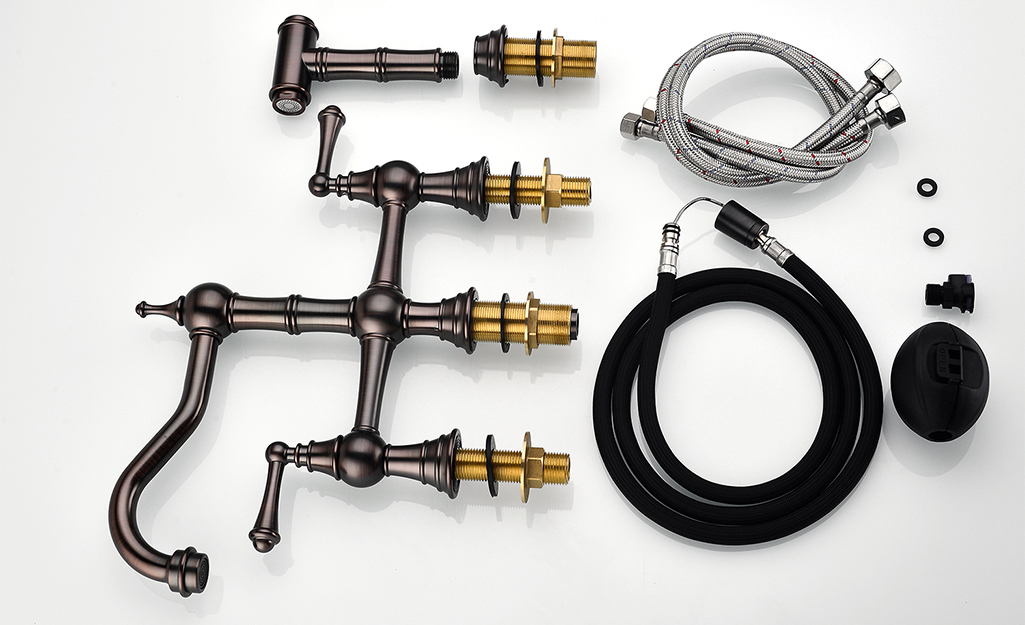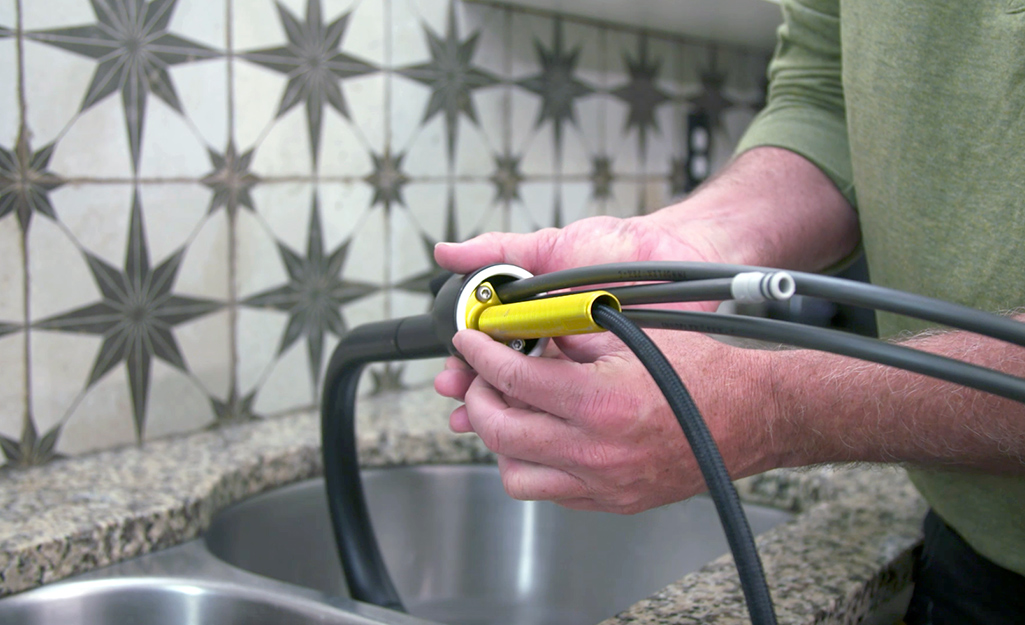How To Install a Two Handle Kitchen Faucet

Last updated September 7, 2023
Upgrading your faucet is an affordable way to improve the convenience and functionality of your kitchen. Whether you're looking to update your faucet for a more on-trend look or to replace it for more function, you'll learn all the steps involved.
This guide will show you how to remove your old kitchen faucet, the basics of faucets and how the number of holes and the spread in your kitchen sink or countertop will determine the type you can install.
Difficulty:
Intermediate
Duration:
Under 2 hours
Table of Contents
Prep for Installation
Disconnect the Water Supply Lines
Disconnect and Remove the Supply Lines From the Faucet
Choose the Right Replacement Faucet
Assemble the New Faucet
Insert the New Hardware and Mounting Nuts
Prep for Installation

Before you remove the old faucet, set yourself up for success with these steps:
- Clear out all of the products and supplies under the sink
- Lay down a mat or towel under the sink to give yourself a comfortable place to work while working under the sink
- Keep a flashlight nearby
- Have a shallow pan or a few old towels to catch any water
- If you have an electrical outlet beneath your sink, flip the corresponding breaker to the off position to turn off the power to the outlet
- Turn the hot and cold water supply valves counterclockwise to shut them off. If you have difficulty, try using a rag or a pair of pliers to improve your grip.
- Open up the faucet handles to relieve any pressure in the lines
Safety tip: Wear safety glasses to protect your eyes from falling debris.
Disconnect the Water Supply Lines

Under the sink, you should see supply lines running from the faucet down to the hot and cold valves. Each supply line is connected to the corresponding valve by a threaded nut.
Use an adjustable wrench to remove each nut by turning it counterclockwise. Stabilize the water pipe as you work so you don’t compromise the connections behind the cabinets. Once you’ve disconnected the water supply line on one side, repeat the process for the other side.
If the valve drips even though the handle is turned off, you have a faulty valve. You’ll need to turn off the water to the entire house to replace it.
Disconnect and Remove the Supply Lines From the Faucet

Water supply lines connect directly to the hot and cold valves on the two handle centerset faucet. Unscrew the supply line connections using tongue and groove pliers or a pipe wrench.
You can see the mounting nuts where the supply lines connect to the sink. They can be difficult to access. A basin wrench can make it easier to unscrew the mounting nuts.
Some faucets also have diverters with a separate supply line that connect the spout and a side sprayer. Disengage this connection before you remove the faucet and sprayer.
With the water supply lines disconnected, you can remove the mounting hardware. You
may need to apply pressure to break any caulk seal.
Clean the area around the sink before installing your new faucet.
Tip: If any of the nuts or mounting hardware is rusted or difficult to remove, apply a penetrating oil to loosen. Give it time to soak in. You may need more than one application.
Choose the Right Replacement Faucet

A centerset faucet is one where the handles and spout are all part of one single unit. A two handle centerset has separate hot and cold handles that connect to the base. These fit cleanly into the outside holes.
The distance between the hot and cold tap holes is known as the spread. You can determine the spread by measuring between the holes at their center point. An 8-inch spread is most common, and is necessary to fit most centerset faucets. For accuracy, take your old faucet to our store to ensure your new faucet will fit.
Confirm your new faucet comes with built-in supply hoses. If it doesn't come with built-in supply lines, you'll have to purchase the correct size flexible supply lines to fit your particular configuration.
Finally, if you’d like a sprayer, consider a faucet model with a pull-out sprayer. These are part of the spout and pull out and retract as needed.
Assemble the New Faucet

For this project, we’re installing a two handle centerset faucet with an escutcheon plate, also called a deckplate. The deckplate slides over the underside of the faucet body. It helps keep moisture from getting between the countertop and the faucet. Other faucets may have a rubber gasket or something that performs a similar function.
Before you set the faucet into the holes, correctly assemble the undercarriage components. Refer to the manufacturer’s instructions for the proper assembly of your new faucet.
Insert the New Hardware and Mounting Nuts

If your faucet requires sealant, apply a 1/4-inch bead of plumber's putty around the base, then set it into the holes.
For most two handle centerset faucets, the anchoring or mounting nuts will go on the underside of the hot and cold valves. Your faucet may install differently, so consult your manufacturer's installation instructions before proceeding.
Screw the mounting nuts onto the threaded valves and tighten them almost up against the underside of the countertop or drop-in sink. Have someone help you line up the faucet behind the sink so the base is completely covering the holes and isn't on an angle. With the base aligned, continue to hand tighten only. If you screw the mounting nuts in too tight, you risk cracking the surface.
Tip: Some faucets will have different mounting hardware, and some manufacturers may have additional hardware for thin decks.
Connect the Water Supply Lines to the Faucet Shanks

A two handle faucet will typically have a threaded shank coming out of each of the hot and cold valves. These are usually 1/2-inch threads that connect with the water supply lines.
To install the water supply line to the shank, take a small strip of plumber’s tape and wrap it clockwise around the threads three times.
Screw on the nut by hand and then tighten it down as much as you can with a wrench. Repeat on the other side.
Connect the Supply Lines to the Water Valve Supply

Next, connect the hot water supply line to the hot water supply valve. This connection is typically a 3/8-inch fitting in most homes.
Wrap the thread of the valve with a strip of Teflon tape, again wrapping it clockwise three times.
Screw on the nut by hand and tighten it down with an adjustable wrench. Secure the pipe for the water supply valve running into the wall as you work, so you don’t damage any connections.
Repeat this process for the cold water supply.
Turn the Water On

With the water supply lines connected, turn the water back on at the hot and cold valves. Test out the operation of your faucet and sprayer while flushing any debris from the system.
Unscrew the aerator from the shaft of the faucet. There may be a tool for this that comes with your faucet, or you may be able to do it by hand. With the aerator removed, turn the handle on and let it run for about a minute.
As it runs, carefully check to make sure there are no leaks. If you detect a slight drip, use a wrench to tighten the connections until the leak stops, but don’t over-tighten.
If you’re still having difficulty, turn off the water, unscrew the nut and add another layer of Teflon tape to the threads. Reattach the supply line, tighten it down, and turn the water back on.
When you are sure you have no leaks, you can replace the aerator, tidy the area and replace the necessary items stored under your sink.
Regular cleaning and maintenance of your faucet will help give you worry-free use for years to come.
Consider updating your faucet to give your kitchen a new look. It’s easy when you know how. This guide can show you how to install a two handle kitchen faucet. Need some tools and materials quick? Home Depot offers delivery options for many of our products. Just say when, where and how.



























